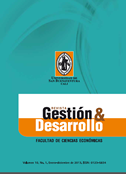La Revista Gestión & Desarrollo proporciona acceso abierto e inmediato a su contenido, basada en el principio de ofrecer al público un acceso libre a las investigaciones para ayuda a un mayor intercambio global de conocimiento.
Excepto que se establezca de otra forma, el contenido de esta revista cuenta con una licencia Creative Commons Attribution-NonCommercial-NoDerivatives 4.0 International (CC BY-NC-ND 4.0) que puede consultar en http://creativecommons.org/licenses/by-nc-nd/4.0/
- Attribution — You must give appropriate credit, provide a link to the license, and indicate if changes were made. You may do so in any reasonable manner, but not in any way that suggests the licensor endorses you or your use.
- NonCommercial — You may not use the material for commercial purposes.
- NoDerivatives — If you remix, transform, or build upon the material, you may not distribute the modified material.
- No additional restrictions — You may not apply legal terms or technological measures that legally restrict others from doing anything the license permits.
Abstract
Competitiveness systemically viewed is not an end but a whole complex process dependent on how the context is organized as a whole. It becomes difficult the understanding, design and policies management around this issue; therefore the aim of this paper is to present the research results of systemic competitiveness. In this case, the results obtained in the implementation phase of the model in a real case, where the level of implementation of the systemic competitiveness model in the sugar cluster was identified. For this a detailed discussion of the topic and systemic model applications that are currently conducting analysis is performed. It is noteworthy that the importance of Asocaña in structures development and strategic alliances staking out that have enabled the development and evolution of both the industry and society was taken as a focal point. Finding that the sugar cluster uses different systemic competitiveness elements; however, it requires actions to strengthen this comprehensive view, to achieve the proper implementation of the model, which is explained in greater detail throughout the article.
Keywords:
References
– _______. (2012). Informe Anual 2011 – 2012. Santiago de Cali (Colombia): Feriva S.A.
– _______. El sector azucarero colombiano en la actualidad. Impacto socioeconómico. Recuperado de: http://www.asocana.org/publico/info.aspx?Cid=215
– Fedesarrollo. (2010). “Impacto socioeconómico del sector azucarero colombiano en la economía nacional y regional”. En: Revista Tecnicaña, No. 25.
– LUNA, C.; COCK, J.; PALMA, A.; VIVAS, L. y MORENO, G. (1995). El cultivo de la caña en la zona azucarera de Colombia. Análisis de la productividad en la agroindustria azucarera de Colombia y perspectivas para aumentarla. Cali: Cenicaña.









